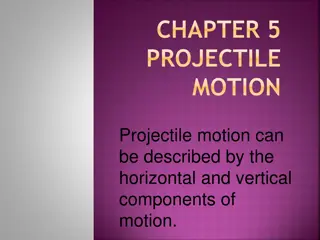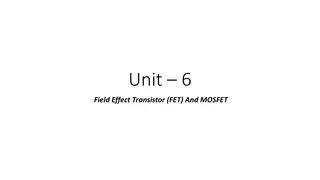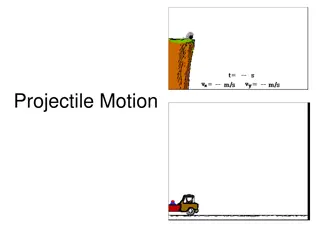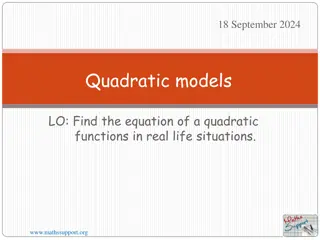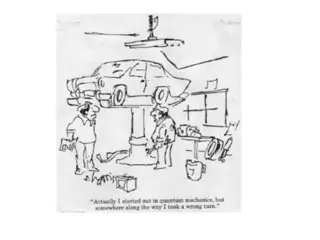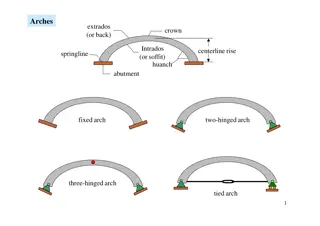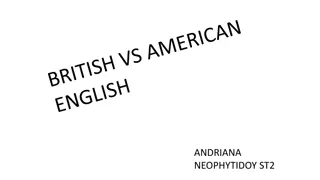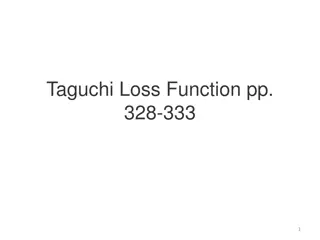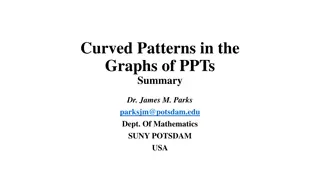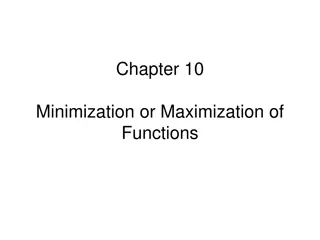
Difference Between Catenary and Parabolic Curves
Explore the distinction between catenary and parabolic curves, common in real-life examples like suspension bridges and satellite dishes. Discover the characteristics of each curve and how they differ, explained by Dr. L. Benedict Michael Raj.
Download Presentation

Please find below an Image/Link to download the presentation.
The content on the website is provided AS IS for your information and personal use only. It may not be sold, licensed, or shared on other websites without obtaining consent from the author. If you encounter any issues during the download, it is possible that the publisher has removed the file from their server.
You are allowed to download the files provided on this website for personal or commercial use, subject to the condition that they are used lawfully. All files are the property of their respective owners.
The content on the website is provided AS IS for your information and personal use only. It may not be sold, licensed, or shared on other websites without obtaining consent from the author.
E N D
Presentation Transcript
PARABOLIC CATENARY BY BY Dr. Dr. L. BENEDICT MICHAEL RAJ L. BENEDICT MICHAEL RAJ HEAD & ASSOCIATE PROFESSOR HEAD & ASSOCIATE PROFESSOR PG & RESEARCH DEPT. OF MATHEMATICS PG & RESEARCH DEPT. OF MATHEMATICS ST. JOSEPH S COLLEGE(AUTONOMOUS), ST. JOSEPH S COLLEGE(AUTONOMOUS), TIRUCHIRAPPALLI TIRUCHIRAPPALLI 620 002 620 002
Dear Students, In todays life, we see Dear Students, In today s life, we see many real life examples of a Parabola. many real life examples of a Parabola. Some of them are Some of them are 1. 1. Suspension Bridges. Suspension Bridges. 2. 2. Flight of a Base ball. Flight of a Base ball. 3. 3. Satellite dishes. Satellite dishes. 4. 4. Smiles Smiles 5. 5. A spider s web (multiple catenaries)and A spider s web (multiple catenaries)and many more many more
Before we proceed to Before we proceed to parabolic parabolic Catenary Catenary, let us see the difference between difference between Catenary Parabolic Parabolic Catenary Catenary. . , let us see the Catenary and and
The The Catenary Catenary and the parabola are and the parabola are two different curves but they look similar. two different curves but they look similar. 1. Parabola, in its simplest form, is, y = x 1. Parabola, in its simplest form, is, y = x2 2 2. 2. Catenary Catenary , on the other hand is , on the other hand is y = y = cosh cosh(x)= (x)=
Figure 1 Figure 1
In the common In the common catenary load per unit length of chain is load per unit length of chain is constant. When a wire is stretched constant. When a wire is stretched tightly between two points, its weight tightly between two points, its weight may be considered to be uniformly may be considered to be uniformly distributed across the span. distributed across the span. catenary, the , the We shall now prove the following We shall now prove the following proposition proposition. .
A string hangs under gravity and A string hangs under gravity and is so loaded that the weight on each is so loaded that the weight on each element of it is proportional to the element of it is proportional to the horizontal projection of that element; horizontal projection of that element; show that it will hang in the form of a show that it will hang in the form of a parabola. parabola.
Let the string be hung from Let the string be hung from the point C and D, let A be its lowest the point C and D, let A be its lowest point and take the horizontal and point and take the horizontal and vertical through O as axes of x and vertical through O as axes of x and y respectively, y respectively,
C D Parabolic Parabolic catenary catenary FIGURE 2 FIGURE 2
1. The three forces T 1. The three forces T0 0 ,T and ,T and wx wx are in equilibrium are in equilibrium. Figure 2 Figure 2
1. 1. 2. 2. The three forces T The three forces T0 0 ,T and They form a triangle of forces with tan They form a triangle of forces with tan = ,T and wx wx are in equilibrium are in equilibrium. = wx wx/T /T0 0 Figure 3 Figure 3
1. 1. 2. 2. 3. 3. The three forces T The three forces T0 0 ,T and They form a triangle of forces with tan They form a triangle of forces with tan = since T is tangential to the curve formed by the since T is tangential to the curve formed by the chain tan chain tan is equal to the gradient at the point P. is equal to the gradient at the point P. ,T and wx wx are in equilibrium are in equilibrium. = wx wx/T /T0 0 Figure 4 Figure 4
1. 1. 2. 2. 3. 3. The three forces T The three forces T0 0 ,T and They form a triangle of forces with tan They form a triangle of forces with tan = since T is tangential to the curve formed by the since T is tangential to the curve formed by the chain tan chain tan is equal to the gradient at the point P. is equal to the gradient at the point P. Gradient = Gradient = wx wx/T /T0 0 ,T and wx wx are in equilibrium are in equilibrium. = wx wx/T /T0 0 4. 4. Figure 5 Figure 5
Consider the equilibrium of a finite Consider the equilibrium of a finite portion OP of the string and let p be portion OP of the string and let p be ( (x,y x,y) . Let w be the weight per unit ) . Let w be the weight per unit length of the string measured length of the string measured horizontally. horizontally.
The forces acting on the portion OP are The forces acting on the portion OP are 1) tension T 1) tension T0 0 at O which is horizontal at O which is horizontal 2) tension T at P acting along the tangent at P, 2) tension T at P acting along the tangent at P, inclined at an angle inclined at an angle to OX to OX 3) weight of the portion OP, 3) weight of the portion OP, Hence these three forces are in equilibrium Hence these three forces are in equilibrium
Resolving horizontally and vertically , Resolving horizontally and vertically , we have, we have, T T cos cos = = T T0 T sin T sin = dividing (2) by (1), dividing (2) by (1), tan tan = = ----------- i.e., = i.e., = ------------ 0 ------------- ------------- = wx wx ------------ ------------ (1) (2) (1) (2) ----------- (3) (3) ------------ (4) (4)
integrating, y = + c integrating, y = + c ---------- ---------- (5) (5) but y = 0 when x = 0, but y = 0 when x = 0, c = 0 c = 0 y = y = ----------- -----------(6) (6) Equation (6) is a parabola with vertex at Equation (6) is a parabola with vertex at the origin and its axis being along the y the origin and its axis being along the y- -axis. axis.
If we put T If we put T0 i.e., T i.e., T0 0 is equal to the load on a length c is equal to the load on a length c of the horizontal span. of the horizontal span. 0 = = wc wc ------------- ------------- (7) (7) Then (6) becomes y = Then (6) becomes y = = = x x2 2 = 2cy (8) is a parabola with (8) is a parabola with lactus = 2cy ------------ ------------ (8) (8) lactus rectum 2c. rectum 2c.
squaring (1) & (2) and adding squaring (1) & (2) and adding ` = w = w = w ` = w2 2(c (c2 2+x = w2 2(c (c2 2+2cy) T T2 2 = T = T0 02 2 + w = w2 2c c2 2+w + w2 2x x2 2 +w2 2x x2 2 +x2 2) ) +2cy) this gives the tension at any point this gives the tension at any point T = w T = w --------- --------- (9) (9)
Now , we discuss about one Now , we discuss about one of the real life parabola (i.e.,) of the real life parabola (i.e.,) Suspension Bridges Suspension Bridges. .
The weight of the chain itself and The weight of the chain itself and the weights of the supporting rods may the weights of the supporting rods may be neglected in comparison with that be neglected in comparison with that of the horizontal roadway. The weight of the horizontal roadway. The weight supported by each of the rods may supported by each of the rods may therefore be taken to be the weight of therefore be taken to be the weight of equal portions of the roadway . Thus , equal portions of the roadway . Thus , we have the case of parabolic we have the case of parabolic catenary catenary. .
The The Menai Menai Suspension Bridge Suspension Bridge Thomas Telford, Completed 1826 Thomas Telford, Completed 1826
Hence the figure of each Hence the figure of each chain of a suspension bridge chain of a suspension bridge approximates very closely to that of a approximates very closely to that of a parabola. We will have therefore two parabola. We will have therefore two parallel parabolas parallel parabolas. .

